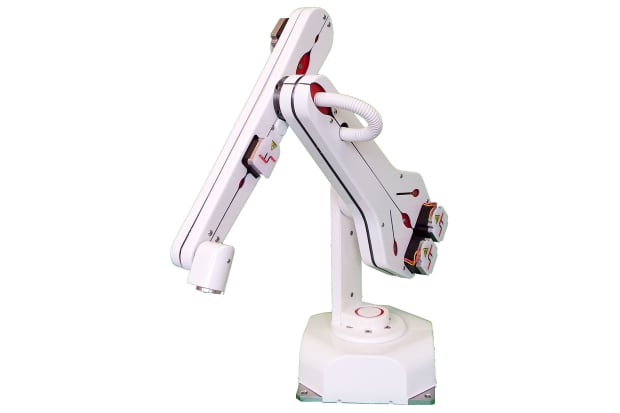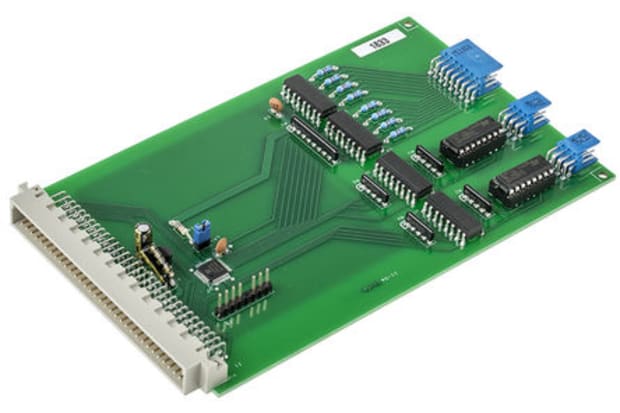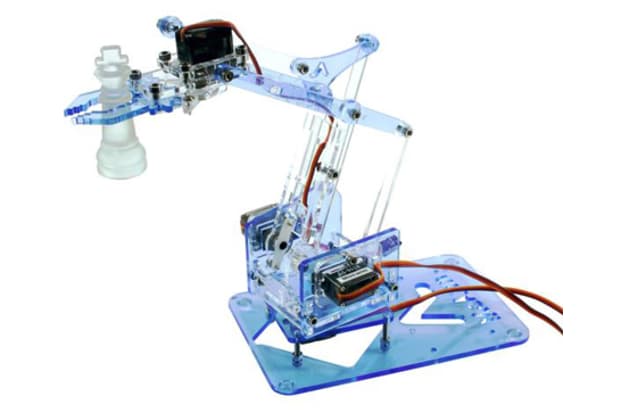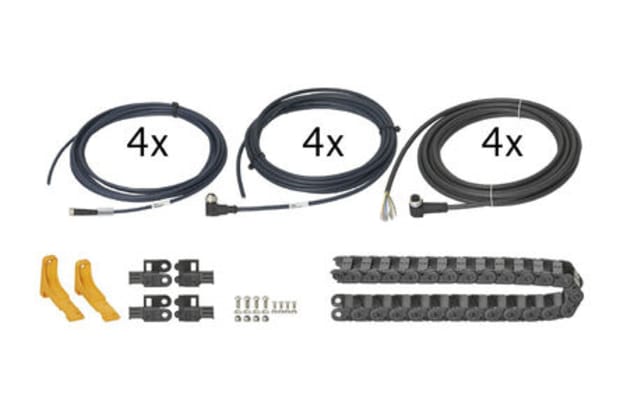- Published 5 Jan 2023
- Last Modified 26 Feb 2024
- 11 min
A Complete Guide to Robotic Arms

This guide is part of our Industrial Automation hub where you can discover more about AI, automation and control.
In this guide, we’ll look at exactly how robotic arms work, what the various different types of programmable robot arms available in the market, and what kinds of roles they’re best adapted to using various accessories or add-ons.
What are robotic arms?
Robotic arms are machines that are programmed to execute a specific task or job quickly, efficiently, and extremely accurately. Generally motor-driven, they’re most often used for the rapid, consistent performance of heavy and/or highly repetitive procedures over extended periods of time, and are especially valued in the industrial production, manufacturing, machining and assembly sectors.
A typical industrial robot arm includes a series of joints, articulations and manipulators that work together to closely resemble the motion and functionality of a human arm (at least from a purely mechanical perspective). A programmable robotic arm can be a complete machine in and of itself, or it can function as an individual robot part of a larger and more complex piece of equipment.
A great many smaller robotic arms used in countless industries and workplace applications today are benchtop-mounted and controlled electronically. Larger versions might be floor-mounted, but either way they tend to be constructed from sturdy and durable metal (often steel or cast iron), and most will feature between 4-6 articulating joints. Again, from a mechanical perspective, the key joints on a robotic arm are designed to closely resemble the main parts of its human equivalent - including the shoulder, elbow, forearm and wrist.

Such is the speed and power that industrial robot arms can work at, there’s a pressing need to be extremely safety-conscious when programming and using them. However, when deployed appropriately, they can vastly increase production rates and accuracy of placement and picking tasks, as well as performing heavy-duty lifting and repositioning functions that would be impossible even for groups of multiple human workers to carry out at any sort of pace.
As technology has advanced and the manufacturing costs of robotic components has fallen over the years, the past decade or so has seen a very rapid expansion in the availability and affordability of robots and robotic arms across a very wide range of industries. This means that they’re far more commonly encountered in smaller-scale operations than they once were, because they’re no longer only an economically viable option for large-scale production lines outputting very high volumes of product.
What types of robotic arms are there?
There are numerous different robotic arm types available on today’s market, each designed with important core abilities and functions that make various specific types particularly well-suited for particular roles or industrial environments. The majority of robotic arms have up to six joints connecting seven sections, most or all of which are driven by various forms of stepper motors and controlled by computer. This allows for incredibly precise positioning of the ‘hand’ or end effector part of the arm, which in most industrial uses will generally be some sort of specialised tool or attachment, designed to carry out a highly specific action or repeatable series of articulations.
For the most part, the key distinction between different sorts of robotic arms lies in the way their joints are designed to articulate - and subsequently the range of movement and functions they’re able to perform - as well as the type of framework they’re supported by and the footprint they require for installation and operation.
In this section we’ll explore some of the more commonly deployed types of programmable robot arms used in all manner of industries worldwide.

Cartesian (gantry) robotic arms
Cartesian robot arms - often referred to as rectilinear or gantry robot arms - are named after the Cartesian coordinate system, developed by René Descartes in the 17th century as a way to map geometric curves onto a graph through the use of algebraic equations.
If all that sounds frighteningly complex, the practical reality is actually quite familiar to most of us in day-to-day workplace uses: Cartesian coordinates are essentially what give us the widely used system of X, Y and (less commonly) Z axes that we almost always see mapped on any typical graph.
In robotic arm terms, mechatronic Cartesian or gantry robots tend to consist of three articulating joints that are programmed using these X. Y and Z coordinates to specify linear movement in three dimensions along these three axes. The wrist joint often provides further rotational functionality.
Cartesian robotic arms use various motors and linear actuators to position a tool or attachment somewhere in three-dimensional space, and manipulate it through a series of linear movements to switch between positions. They can be mounted horizontally, vertically or overhead, and are widely used in a range of applications such as machining parts or picking and placement alongside conveyor belts.

Cylindrical robotic arms
Cylindrical robot arms, in contrast to the Cartesian versions outlined above, are ones whose axes form a cylindrical coordinate system - in short, their programmed movements take place within a cylinder-shaped space (up, down and around). This type of arm is more commonly used for assembly operations, spot-welding and machine tool handling, where the rotary and prismatic joints give it both rotational and linear motion.
Polar/Spherical robotic arms
Again, just like the cylindrical robotic arms described above, a polar or spherical robot is one that operates within a spherical ‘work envelope’ or potential locus of movement. This is achieved through a combined rotational joint, two rotary joints, and a linear joint. The polar robotic arm is connected to its base via a twisting joint, and the subsequent spherical workspace it has access to make it useful for performing similar roles as cylindrical robotic arms - handling machine tools, spot welding, die casting and arc welding.
SCARA robotic arms
SCARA robot arms are most widely used in assembly and pick and place applications. The acronym SCARA stands for Selective Compliance Assembly Robot Arm (or sometimes Selective Compliance Articulated Robot Arm), which is a reference to their ability to tolerate a limited degree of ‘compliance’ - flexibility, in the context of robotics - along some axes, while remaining rigid in others.
SCARA robotic arms are perhaps the classic type you might think of when you picture a high-tech production line, and it’s their selective compliance capabilities which make them ideal for these purposes. For certain assembly and placement tasks, a degree of tolerable flexibility in particular directions but not others is highly advantageous, allowing for insertion of components into tight-fitting spaces without binding or damaging any of the parts.
What are robotic arms used for?
Robotic arms can be used for all manner of industrial production, processing and manufacturing roles - any task in which extremely precise, fast and repeatable movements are required, in fact.
Robotic arms of all kinds are used today at every scale of manufacturing, from minutely detailed circuit board assembly to large-volume heavy industries such as automotive production lines, as well as in a huge range of ‘pick and place’ (conveyor belt) applications. This means that it’s important to know which types of programmable robotic arms are better suited to which sorts of environments and tasks before you begin planning a purchase.
In every case, selecting the right type of programmable robot arm for a given role or task should involve consideration of the intended application’s precise nature and requirements. These will typically include:
- Load
- All types of robotic arms have a given load capacity, and this manufacturer-specified number always needs to exceed the total weight of the payload involved in any job you expect the arm to perform (including tools and attachments).
- Different sorts of robot arms are supported by differently designed frameworks, which can increase or decrease overall load capacity - this must be balanced with consideration of physical placement and footprint.
- Orientation
- This criterion is generally defined by the footprint and mounting position of the robotic arm, and how well it fits alongside the other equipment in your production line for the range of movements and manipulations it’s expected to perform. This will in turn influence where the arm can physically be positioned relative to the objects it will be moving.
- Certain types of robotic arms require bulkier pedestals or more physical clearance space to perform their programmed range of movements, and these factors must be considered in terms of other equipment or workers in the vicinity.
- Speed
- Particularly when choosing robotic arms for picking and placement applications, it’s important to pay attention to manufacturer ratings for speed, and especially in terms of acceleration over longer distances.
- Changes and upgrades to speed ratings can be achieved in some types of robotic arm through changes made to the choice of belts, motors or actuators used.
- Travel
- Tolerances and accuracy over wider spans can be reduced in certain types of robot arms, due to arm deflection and differences in support framework design.
- If the application requires longer travel distances between payloads or work areas, this may dictate which sorts of robotic arms would be suitable or unsuitable for performing the task, depending on the tightness of tolerances required.
- Precision
- Certain types of programmable robotic arms are inherently designed to be more precise in their range of movements and articulations than others. This may come at higher cost for a more complex machine, and involve a compromise against other factors such as footprint, speed, potential travel distance and orientation.
- For many industrial applications such as picking and placement, robotic arms capable of extremely precise repeatable movement may be an unnecessary expense. However, for tooling applications, precision will be a key consideration before most other factors. Again, changes and upgrades can be made to improve precision for certain types of robotic arm, but not all.
- Environment
- Consideration of atmospheric conditions and potential hazards (including dust, dirt and moisture levels) in the immediate working environment will be important when choosing an appropriate type of robotic arm for a specific location.
- Physical footprint, orientation and range of movement will also influence how suitable a particular model or arm type is for use in a particular environment, with other equipment and workers taken into account.
- Duty cycle
- This is essentially an evaluation of how intensively the robotic arm will be expected to perform, and for how long between ‘rest’ or maintenance periods. Wear and tear will obviously become a problem sooner for a robot arm that is run continuously, as opposed to one which is only operated during standard shift cycles.
- Different models or arm types will require different maintenance regimes, such as lubrication intervals and parts replacement - in any environment where minimal downtime is critical, these will be important considerations to bear in mind when buying robotic arms for specific production roles.
Collectively, the criteria above are sometimes referred to as a robot’s LOSTPED parameters.
Summary
Robot arms are ideal for operations which are repetitive, consistent and require a very high degree of accuracy, as well as for applications in which a human worker might struggle to perform safely.
Robotic arms are fast, accurate and reliable, and can collectively be programmed to perform an almost infinite range of different operations. The dramatic reduction in buy-in costs for industrial robotic arms over the past decade has seen them rise to far more widespread use today than ever before - whether desktop-mounted or installed as part of a high-volume production line, robotic arms are now commonly found across a broad range of industries and sectors, including:
- Laboratories
- Testing & sample handling
- Manufacturing
- Industrial automation
- Automated assembly
- Machine feeding
- Machine access
Robot arm assembly and construction kits are often sold with different attachments to help them perform their assigned duties. These can range from grippers or suction cups to a wide range of sensors and robotic controllers that provide complex environmental response capabilities.
Product spotlights
Browse our most popular robotics product categories:



